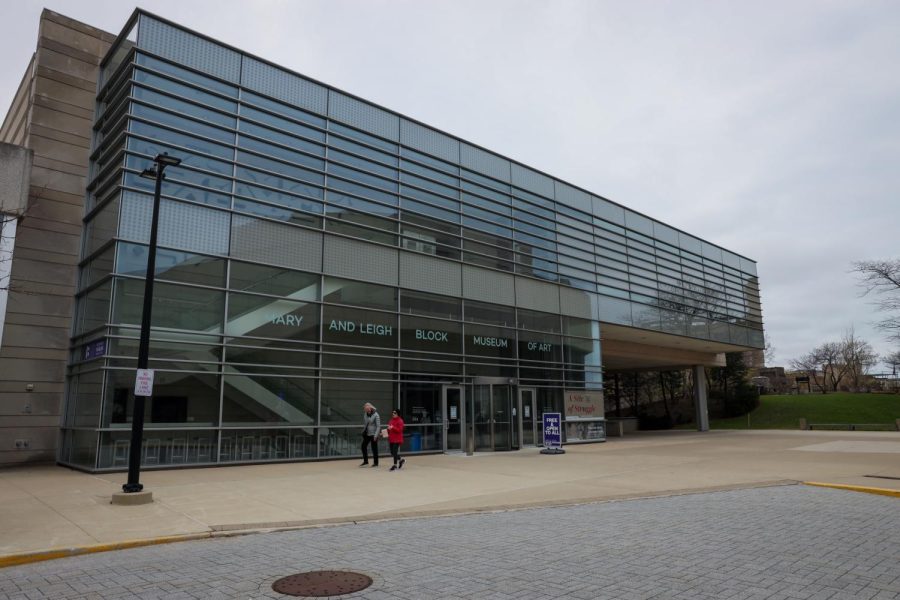Tsai Ming-Liang visits Block Museum for screening and discussion
The Block Museum. Director Tsai Ming-Liang and actor Lee Kang-Sheng came to the museum to speak Friday.
October 2, 2022
Award-winning Malaysian-Taiwanese director Tsai Ming-Liang and actor Lee Kang-Sheng visited the Block Museum for a screening of the “Walker series” Friday.
Through the work Tsai depicts Lee, dressed as a Buddhist monk, traversing numerous countries and landscapes in a series of meditative performance films. At the event, the audience watched two installments of the series — “Journey to the West” and “No No Sleep” — and heard the two speak about their work.
“Walker is a very spontaneous project, but each ‘walker’ has its own concept,” Tsai said.
Tsai said the series originated from a one-man show, in which he asked Lee to walk across a theater stage. While the two initially struggled with the concept, Lee later decided to simply walk across the stage, taking about 17 minutes to cross from one side to the other. Recognizing the breakthrough, Tsai asked Lee to walk even slower.
In four subsequent performances, Lee spent half an hour walking across the stage. The two decided to immortalize the concept, translating the theatrical performance into a series of films.
During the discussion, Tsai also released details about his upcoming ninth film in the Walker series, which he filmed in Paris in June. The Centre Pompidou is sponsoring eight Walker films for a retrospective exhibition later this year and asked Tsai if he could film another in Paris.
With around ten different edits, the ninth film could be the longest installment at about 90 minutes in the “Walker series.”
“Of course, it has no story,” Tsai said. “The focus is still Lee Kang-Sheng walking.”
Stanford University Prof. Jean Ma facilitated the discussion. Ma has been watching Tsai’s films since the late 1990s, but Friday was the first time she met him in-person.
“I’ve seen the films on a small screen, but it was my first time seeing them projected, and it really was incredible. The films feel different. The visual detail comes out,” Ma said. “(You can) feel the time passing differently in your body when you are in a theater with other people.”
Tsai also seeks to combine spontaneity with planning in his films. In one of the most visually striking shots in “Journey to the West,” Lee walks down the steps to a subway station.
Tsai said he calculated the sunlight’s timing the day prior to filming. What he did not calculate, however, was that this particular time of day was when schools release students. As children and people rushed down the stairs, a cloud of dust enveloped the walker, forming a halo reminiscent of Buddhist imagery, Tsai said.
Likewise, two famous scenes from “No No Sleep” originated only because Lee was suffering from neck problems. Tsai asked Lee to recuperate at a bathhouse the next day and ended up filming there.
Tsai said sometimes he doesn’t know what he is doing with the Walker series. Instead, he said the series is like a pursuit of cinema.
Filmmaker Liyan Zhao traveled from Milwaukee for the screening.
“I found that to be a very luxurious experience,” Zhao said of the film. “I feel like it’s very rare to be able to slow down and not feel pressure that you’re not doing enough or things aren’t going quite enough.”
Despite his original plan to end the Walker series with 10 installments, Tsai is now less sure of the series’ end date.
“Til when will the walker walk? The walker will walk until one of us is no longer here,” Tsai said. “I want to keep filming Lee Kang-Sheng. I want to see him walk at the age of 70, 80.”
Email: [email protected]
Twitter: @zhizhong_xu
Related Stories:
— Block Museum hosts film screenings about Chicago neighborhoods
— Block Museum exhibition ‘Taking Shape: Abstraction from the Arab World’ redefines modernism
— The Block Museum’s ‘Looking 101’ exhibit helps visitors practice analyzing artwork












